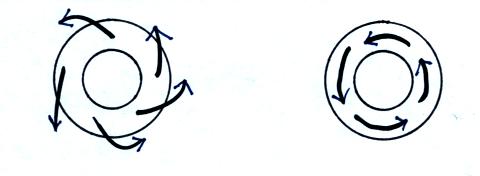
Answer: the LEFT figure. Surface winds blow across the contour lines toward low pressure. The right figure shows upper level winds blowing parallel to the contours.
2. For each figure below indicate whether the net force is INward, OUTward, or zero.

Answer: An inwardly directed force is needed to keep an object moving in a circular path. Just the "right amount" of inward force is present in the middle figure. The object moves in a circle that doesn't get bigger or smaller. A little more than the right amount of inward force is present in the right figure. The object spirals inward. A little less that the right amount is present in the left figure and the object spirals outward.
3. The wind is blowing in a straight line parallel to the contours in the figure below. Does the PGF point UP, RIGHT, DOWN, or LEFT at the point shown?
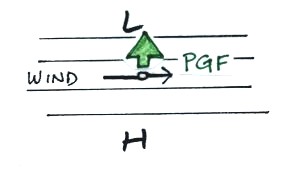
Answer: The PGF points UP (as shown above). The PGF is always perpendicular to the contour lines and points toward low pressure. Don't let the wind direction mislead you. Follow the rule to the letter.
4. Which figure shows winds blowing in the southern hemisphere?
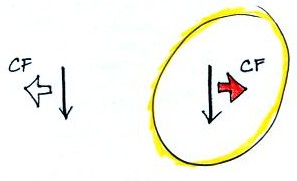
Answer: The Coriolis force in the southern hemisphere will be perpendicular to and point to the left of the wind. You need to turn the picture upside down so that you are looking in the direction the wind is blowing (looking downstream) and then draw an arrow to the left of the wind.
5. Show the directions of the PGF and the CF at the point shown in the figure below.
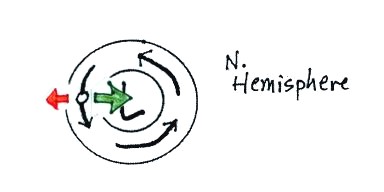
Answer: The PGF (green arrow) points inward toward low pressure and the CF (red) is perpendicular and to the right of the wind (when looking in the direction the wind is blowing). Note the PGF is stronger than the CF, so there is a new inward pointing force.
6. Does the figure show winds spinning around HIGH or LOW pressure? Is this the NORTHERN or SOUTHERN hemisphere?
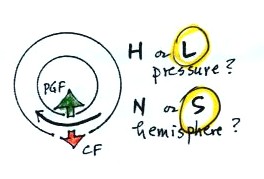
Answer: The PGF (green) always points toward low pressure. This must therefore be a center of LOW pressure. The Coriolis force (red) is perpendicular and to the left of the wind, making this a SOUTHERN hemisphere map.
7. Show the directions of the PGF and the CF at the point shown.
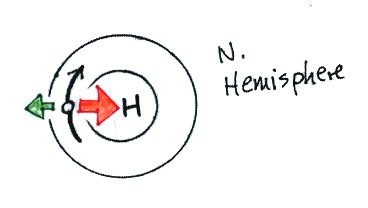
The PGF (in green) points toward low pressure (away from high pressure). The CF (red) is perpendicular and to the right of the wind. The CF is stronger than the PGF so there is an inward pointing net force.
8. Are these UPPER LEVEL or SURFACE winds? Blowing in the NORTHERN or the SOUTHERN hemisphere? Does the net force point INWARD or OUTWARD?
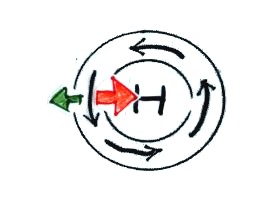
Answer: There are first of all UPPER LEVEL winds. You can tell because the winds are blowing parallel to the contour lines. Next draw in the PGF force (green arrow) pointing away from high pressure. The CF ends up being to the left of the wind making this a SOUTHERN hemisphere chart. In the case of circular motion there is always an INWARD force.
9. Identify the 3 forces (PGF, CF, and F) in the figure. Is this a NORTHERN or a SOUTHERN hemisphere weather map? (look closely, one of the forces is perpendicular to the contours, and another is perpendicular to the wind, the 3rd points opposite the wind)
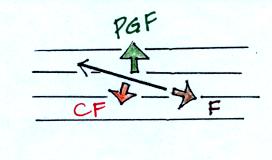
10. This last question asked whether you liked the music played before the start of class. There is no right or wrong answer to this question of course.
Some Irish music (Hibernian Rhapsody by De Dannan) was played in the Friday afternoon class. The T Th class will get a chance to listen to this before the quiz on Thursday.
A couple of songs, sung mainly in Italian, were played before the start of class Tuesday morning. The first song (La Voce del Silenzio) was a duet featuring Andrea Bocelli and Elisa. The MWF class hasn't heard this one yet - they may get a chance before the quiz on Wednesday. The second song (Dare to Live [Vivere] ) was my favorite and paired Andrea Bocelli and Laura Pausini.
So far no serious complaints about the music played before class.